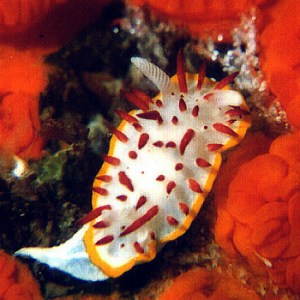
Diaphorodoris papillata
Portmann & Sandmeier, 1960
Order: NUDIBRANCHIA
Suborder: DORIDINA
Superfamily: ANADORIDOIDEA
Family: Onchidorididae
DISTRIBUTION
Mediterranean
PHOTO
Bay of Algeciras (Strait of Gibraltar, southern Spain) at 16m depth. Size: 15 mm. July, 1999. PHOTO: Alma Sánchez
Characterised by the red, pointed dorsal papillae and yellow mantle border. feeds on encrusting bryozoans and grows to about 10mm.
Reference:
• Portmann, A. & Sandmeier, E. (1960) Zur Kenntnis von Diaphorodoris (Gastr., Nudibranchia) und ihrer mediterranen Formen. Verh. Nat. Gesel. 71: 174-183.
Rudman, W.B., 2001 (February 7) Diaphorodoris papillata Portmann & Sandmeier, 1960. [In] Sea Slug Forum. Australian Museum, Sydney. Available from http://www.seaslugforum.net/find/diappapi
Related messages
Diaphorodoris papillata from Malta
July 12, 2007
From: Patricia Peels

Dear Bill
Another sighting for the records of Diaphorodoris papillata.
Recently we seem to find more nudibranchs on our dives. The winter was rather mild and I believe, the temperature of the sea remained 1-2ºC above normal. Could that be the reason? Or maybe we are just getting better at spotting them.
Locality: Cirkewwa, 15 m, Malta, Mediterranean, 19 May 2007, wall with sponges. Length: 5 mm. Photographer: Patricia Peels.
Best regards,
Patricia Peels
gmpeels@nextgen.net.mt
Peels, P., 2007 (Jul 12) Diaphorodoris papillata from Malta. [Message in] Sea Slug Forum. Australian Museum, Sydney. Available from http://www.seaslugforum.net/find/20141Dear Patricia,
Without good records of sightings over many years it hard to know whether differences are just in the mind, or natural fluctuations or long term trends. I'm sure that the more experience you have in looking and finding nudibranchs will have a lot to do with any increase in your success rate - at least in the first few years of looking for them.
Best wishes,
Bill Rudman
Re: Diaphorodoris papillata from the Mediterranean
June 20, 2007
From: Dominique Horst

Concerning message #16760:
Hello,
I cannot resist to send these pictures to the forum. This Mediterranean Diaphorodoris papillata is one of the most colourful I've ever met in our area.
Locality: Cap d'Antibes, 18 m, France, Mediterranean sea, 8 April 2007. Length: 4-7 mm. Photographer: Dominique HORST.
I didn't notice it before, but it seems that eyes are located at the root of the rhinophores which are transparent. Could you confirm that these black point are the eyes and the transparent rhinophore a kind of protection through which they can see ?
Many thanks and kind regards,
Dominique
dominique.horst@wanadoo.fr
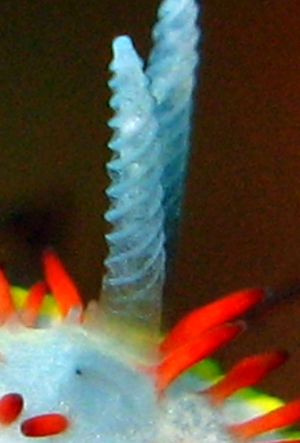
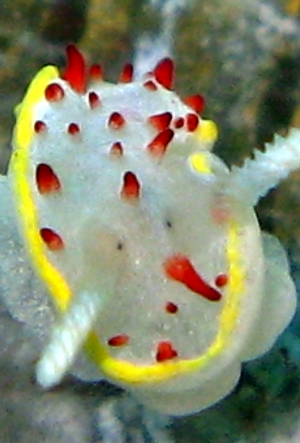
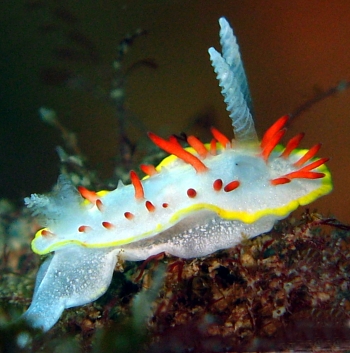
Dear Dom,
You are allowed to share photos and observations that excite you - I can assure you there are many equally eccentric visitors to the forum who find such things just as fascinating.
The small black spots are indeed their eyes which are attached to the side of their cerebral ganglia which is part of an aggregation of nerve cells which forms a collar around the oesophagus, and can be called their 'brain'.
Many nudibranchs with a heavily pigmented skin have a pigmentless 'window' like this which certainly allows light to reach the eyes. Have a look at the centre right photo in message #19132 which shows similar clear patches in Tambja abdere. Since their eyes can't form images, these 'windows' are not for the view, but they may allow the eyes to see shadows passing over the body and warn of a potential predator, or they may just help set the animal's 'body clock' so it knows night from day.
Best wishes,
Bill Rudman
Diaphorodoris papillata is still in Israel
May 23, 2007
From: Dani Barchana
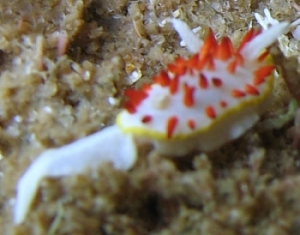
Concerning message #16846:
This is my first message to the Forum. I saw the interest in Diaphorodoris papillata and that it is supposed to be only in the western Mediterranean.
I saw it today on the Israeli cost (near Caesaria), at a beach called Michmoret, 3 meters deep, 2-2.5 cm long.
Sorry for the quality of the picture.
Locality: Michmoret, 3 meters, Israel, Mediterranean Sea, 18 May 2007, Rockery. Length: 20-25 mm.. Photographer: Dani Barchana.
Dr Dani Barchana
dani.barchana@gmail.com
Barchana, D., 2007 (May 23) Diaphorodoris papillata is still in Israel. [Message in] Sea Slug Forum. Australian Museum, Sydney. Available from http://www.seaslugforum.net/find/19927Dear Dani,
Thanks for this further record of Diaphorodoris papillata from the eastern Mediterranean. It certainly appears to be a permanent resident.
Best wishes,
Bill Rudman
Re: Diaphorodoris papillata from Caeserea, Israel
June 14, 2006
From: Matan Ninio

Concerning message #16787:
As usual, following the identification of Diaphorodoris papillata from our waters, we got additional sightigs. In this case it was Anat Lynn, one of the members of our local slug-forum, that noticed a couple of D. papillata hidden away in the background of two of her photographs - she was photographing a scorpion-fish at the time. It's a shame she hadn't noticed them in real time, as she is superb photographer.
Locality: the Bonim beach, about 5m, Israel, Mediterranean, 3 June 2006. Photographer: Anat Lynn.
Matan Ninio
mn@forumHasofiotyah.dive.ninio.org
Ninio, M., 2006 (Jun 14) Re: Diaphorodoris papillata from Caeserea, Israel. [Message in] Sea Slug Forum. Australian Museum, Sydney. Available from http://www.seaslugforum.net/find/16846Thanks Matan,
Best wishes,
Bill Rudman
Re: Diaphorodoris papillata from the Mediterranean
June 6, 2006
From: Dominique Horst
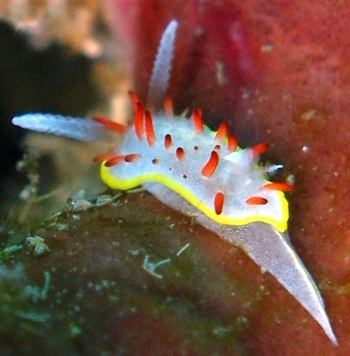
Concerning message #7577:
Thanks to your Forum, the identification of this species was easy... I've found only specimens that are very small, between 3 and 5 mm. In the end I've got some pictures that can be shown. Here are 2 of them.
Locality: Cap d'Antibes, 10 m, France, Mediterranean sea, 30 May 2006, vertical rock. Length: 5 mm. Photographer: Dominique Horst.
Best regards,
Dominique
dominique.horst@wanadoo.fr
Horst, D., 2006 (Jun 6) Re: Diaphorodoris papillata from the Mediterranean. [Message in] Sea Slug Forum. Australian Museum, Sydney. Available from http://www.seaslugforum.net/find/16760
Dear Dominique,
Diaphorodoris papillata is a spectacular little nudibranch
Best wishes,
Bill Rudman
Diaphorodoris papillata from Caeserea, Israel
June 6, 2006
From: Matan Ninio

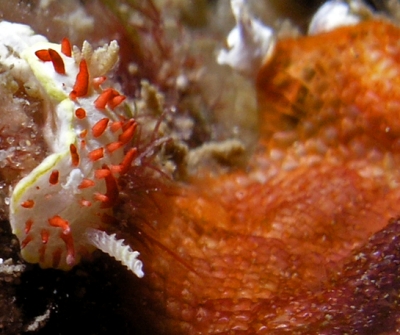
Hi Bill,
I can't recall ever seeing this, so I figured you may want the images. We are getting an unusal flow of unusual slugs in the Mediterranean.
Locality: Caesarea, 7 m, Israel, Mediterranean Sea, 31 May, 2006, rocky reef. Length: 15 mm. Photographer: Yousai.
Matan Ninio
matan@forumhasofiot.yam.dive.ninio.org
Ninio, M., 2006 (Jun 6) Diaphorodoris papillata from Caeserea, Israel. [Message in] Sea Slug Forum. Australian Museum, Sydney. Available from http://www.seaslugforum.net/find/16787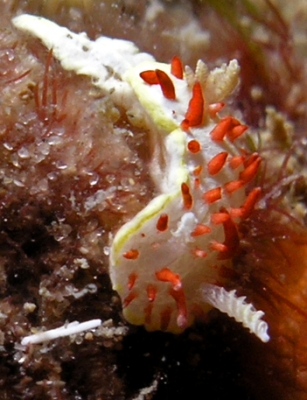
Dear Matan,
I wondered if you shared your time between the Red Sea and the Mediterranean. It's quite a coincidence getting two messages, from opposite ends of the Mediterranean, about Diaphorodoris papillata [see message #16760]. I may be wrong but I think this species has only been reported from the western Mediterranean before, so this could be an interesting find.
It is reported to feed on encrusting bryozoans, and I suspect the brownish - orange object in your photos is just such an encrusting bryozoan.
Best wishes,
Bill Rudman
Diaphorodoris papillata from the Mediterranean
July 27, 2002
From: Marina Poddubetskaia
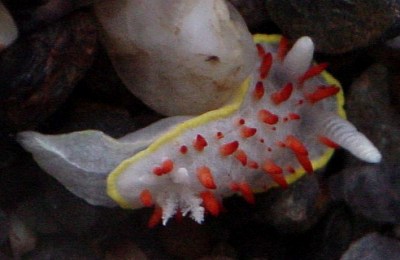
Dear Bill,
Here is a photo of Diaphorodoris papillata.
Date: July 01, 2002
Location: Cerbere, France [Mediterranean coast]. Site: Les 3 moines
Size: 10-12mm
Photos: Marina Poddubetskaia - Nembro website
Best wishes,
Marina.
nembro@nembro.info
Poddubetskaia, M., 2002 (Jul 27) Diaphorodoris papillata from the Mediterranean. [Message in] Sea Slug Forum. Australian Museum, Sydney. Available from http://www.seaslugforum.net/find/7577Thanks Marina,
Bill Rudman
Diaphorodoris papillata from Croatia
January 16, 2002
From: Mirta Moraitis

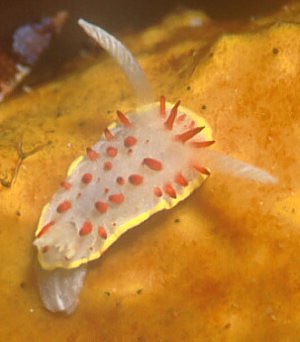
Dear Bill,
I found this nudibranch this summer in the island of Krk, Croatia,in the Mediterranean sea. According to the dimensions of a shell near it, it's about 1cm of length. I found it at 9meters of depth, at 20.5°C.
I would like assistance in identifying it please. I think it is a Diaphorodoris papillata but I'm not sure.
Thanks,
Mirta
dipingu@libero.it
Moraitis, M., 2002 (Jan 16) Diaphorodoris papillata from Croatia. [Message in] Sea Slug Forum. Australian Museum, Sydney. Available from http://www.seaslugforum.net/find/5983Dear Mirta,
Thanks for the photos. Yes I think you are correct with your identification but would value some comments from colleagues more familiar with the Mediterranean fauna. One thing that does puzzle me is the length of the rhinophores, which seem proportionally much larger than in many illustrations I have seen, and certainly larger than in Alma Sánchez's photo. Is the relative size something to do with age? Is it like the situation in many chromodorids where the rhinophores of juveniles are proportionally much larger than in adults?
Best wishes,
Bill Rudman
Diaphorodoris papillata from Spain
February 10, 2001
From: Alma Sánchez

Dear Dr. Rudman,
Here is a photo of Diaphorodoris papillata Portmann & Sandmeier, 1960 for your Forum.
This specimen was collected in July, 1999 at the Bay of Algeciras (Strait of Gibraltar, southern Spain) at 16m depth. Size: 15 mm.
Best wishes,
Alma Sánchez
almasanchez83@hotmail.com
Sánchez, A., 2001 (Feb 10) Diaphorodoris papillata from Spain. [Message in] Sea Slug Forum. Australian Museum, Sydney. Available from http://www.seaslugforum.net/find/3758Thanks Alma,
Bill Rudman
